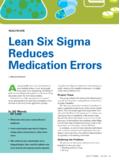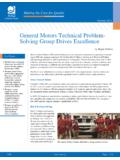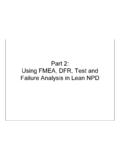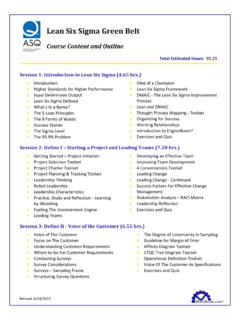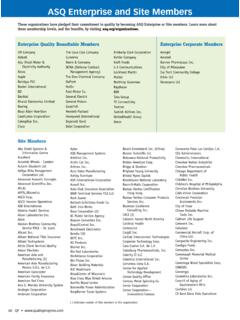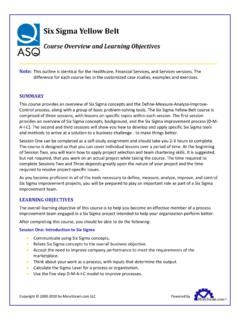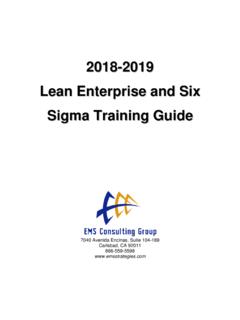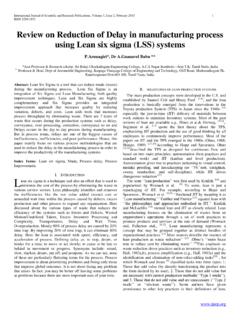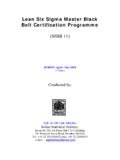Transcription of Learning Objectives – Lean Six Sigma Black Belt …
1 Communicate using Six Sigma about your organization as a collection of processes, with inputs that determine the Six Sigma concepts to the overall business mission and the concept of a Sigma level to evaluate the capability of a process or and apply the five-step DMAIC model as a framework to organize process improvement a wide range of process improvement techniques, including design of experiments, within the DMAIC the organizational factors that are necessary groundwork for a successful Six Sigma your Six Sigma skills to lead a successful process improvement project and deliver meaningful results to the organization. The overarching Learning objective of this course is to develop a comprehensive set of skills that will allow you to function effectively as a Six Sigma Black Belt. The Black Belt body of knowledge includes techniques for both quantitative and non-quantitative analysis, as well as the team leadership skills necessary to get projects across the goal completing this course, you should be able to DO the following: Learning Objectives lean Six Sigma Black Belt Course Powered by MoreSteam1.
2 Introduction What is Six Sigma ? Input/Output (X and Y) Relationship Six Sigma and lean Enterprise Defects Per Million Opportunities Metric (DPMO) Success Stories Six Sigma History DMAIC Process Thought Process Mapping Six Sigma Organizational Structure Role of the Black Belt Exercises and Quiz2. Define I Prioritize Process Thinking Process Mapping Flow Charts, Value-Added Flow Charts, Deployment Flow Charts Spaghetti Diagrams Value Stream Mapping (Takt Time, Line Balancing) Balanced Scorecard Pareto Chart Project Selection Project Charter Project Tracking Gantt Chart Stakeholder Analysis Exercises and Quiz3. Define II Voice of the Customer Customer Satisfaction & Kano Model Sample Surveys Survey Construction Margin of Error Affinity Diagrams CTQC Tree Diagrams, Critical to Quality Characteristics (CTQCs) Setting Specifications Quality Function Deployment Operational Definition Exercises and Quiz4.
3 Measure I Variable and Attribute Data Sampling Plan Measurement System Analysis Data Collection Check Sheet Benchmarking Baseline DPMO & Sigma Conversion Rolled Throughput Yield Exercises and Quiz5. Measure II Trend Chart Histograms Measuring Process Variability Statistical Process Control Rational Subgrouping X and Moving Range Control Charts Attribute Control Charts X-bar and R Control Charts Process Capability Exercises and QuizCourse Content and Outline lean Six Sigma Black Belt Powered by MoreSteam6. Analyze I Potential Root Cause Cause and Effect Diagrams (Fishbone Charts) Five-Why, One-How FMEA Scatter Plots Regression and Correlation Analysis Multiple Regression Logistic Regression Exercises and Quiz7. Analyze II Hypothesis Testing Introduction to Hypothesis Testing Confidence Intervals and Hypothesis Testing Comparison of Two Treatments: Z-test, F-Test, t-test Comparison of Multiple Treatments ANOVA, Chi-Square for Multiple Proportions Comparison of Variances Chi-Square Test Non-parametric Testing Hy-Court TV TM Learning Lab Exercises and Quiz8.
4 Analyze III Design of Experiments Introduction to Design of Experiments Single Factor Experiments Full Factorial Experiments Fractional Factorial Experiments General Factorial Experiments Experiment Simulations Advanced Topics Exercises and Quiz9. Improve Design for Manufacturability/Serviceability/Repaira bility (DFSS) Brainstorming Continuous Flow (Little s Law) Quick Changeovers Implementing Work Cells Theory of Constraints Pull Scheduling Narrowing the List of Ideas FMEA Error-proofing Corrective Action Matrix Piloting a Solution System Dynamics Exercises and Quiz10. Control Control Plan SPC Revisited FMEA Revisited Visual Control 5-S CHECK Process Total Productive Maintenance Best Practices Integrating Success Exercises and Quiz11. Tools for Success Leadership Team Development Leading Teams Leading Change Exercises and Quiz Powered by MoreSteamThis lean Six Sigma Black Belt course is comprised of 11 separate sessions (or units).
5 Each session is a collection of related lessons and includes an interactive quiz at the end of the session. Most of the lessons include interactive practice exercises. All course material is available online, and sessions may be started and stopped at any point content is delivered on-demand according to your completing this course of study, you will gain a solid general knowledge of the theory, composition, and implementation of a lean Six Sigma initiative. You will also become proficient in all of the analytical tools necessary to define, measure, analyze, improve, and control lean Six Sigma improvement projects, including the design and analysis of general and fractional factorial experiments. You will learn team leadership and project management skills. In short, as a Black Belt you will master the skills necessary to lead a complex process improvement project that produces bottom-line Structure and RequirementsThis course provides content on-demand to offer the highest degree of student flexibility.
6 You can set your own schedule and progress at your own speed, terminating and re-entering sessions whenever you course sessions use a mix of multimedia to present material, including text, synchronized audio slide shows, diagrams, charts, audio lectures, and simulations. Links to outside research resources are provided to explore chosen subjects in greater you work through the course you will be asked to demonstrate knowledge and understanding in four ways:Interactive Practice Exercises will be presented throughout each session so that you can try your new skills and get immediate Exercises will be presented at the end of every session to practice new concepts. Supplemental exercises are self-graded and may be shared in the Virtual Classroom Discussion will be conducted at the end of every session. Quizzes are interactive and provide immediate feedback to close the Learning Overview lean Six Sigma Black Belt Powered by MoreSteamBlack Belt Project: A Six Sigma project must be completed successfully and submitted for evaluation before a Black Belt certification is awarded.
7 The project must demonstrate full knowledge of Six Sigma concepts and tools, and must deliver actual bottom-line project is submitted at two points: after the definition phase to ensure that the project will meet the guidelines for Black Belt certification, and upon SequenceThe course is presented in a logical sequence to follow the Six Sigma DMAIC improvement process. We believe that you will learn most efficiently by following the sequence presented. In particular, the first session presents an overview of Six Sigma , which will be helpful to put the remaining sessions in proper context. However, the sessions are modular, and we encourage you to explore the material. You are free to move forward and backward throughout the course. You can skip ahead or go back and review material that you already covered. The course map feature allows point-to-point navigation, from anywhere to anywhere.
8 The course map status column will tell you which pages you have not visited. Powered by MoreSteam
